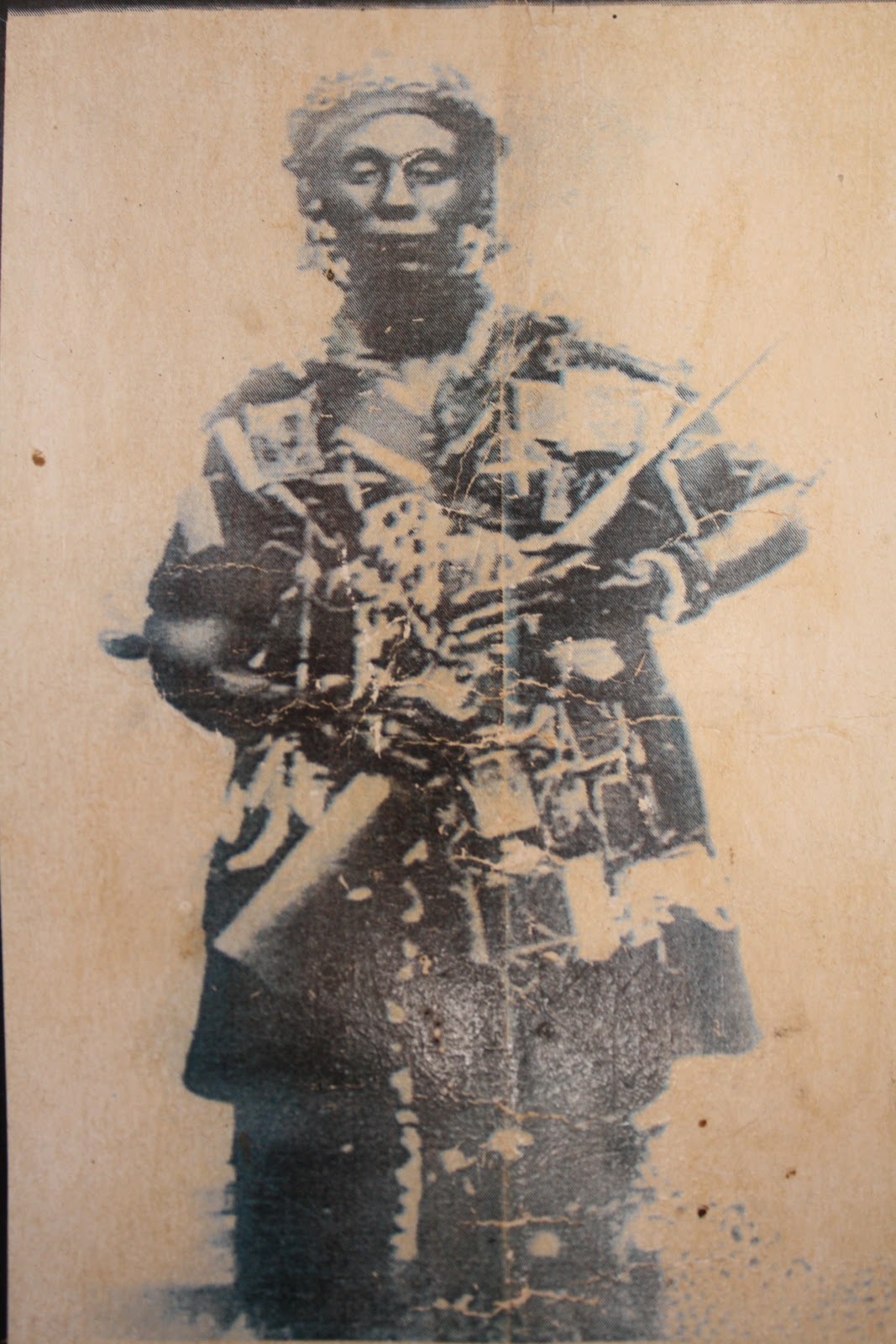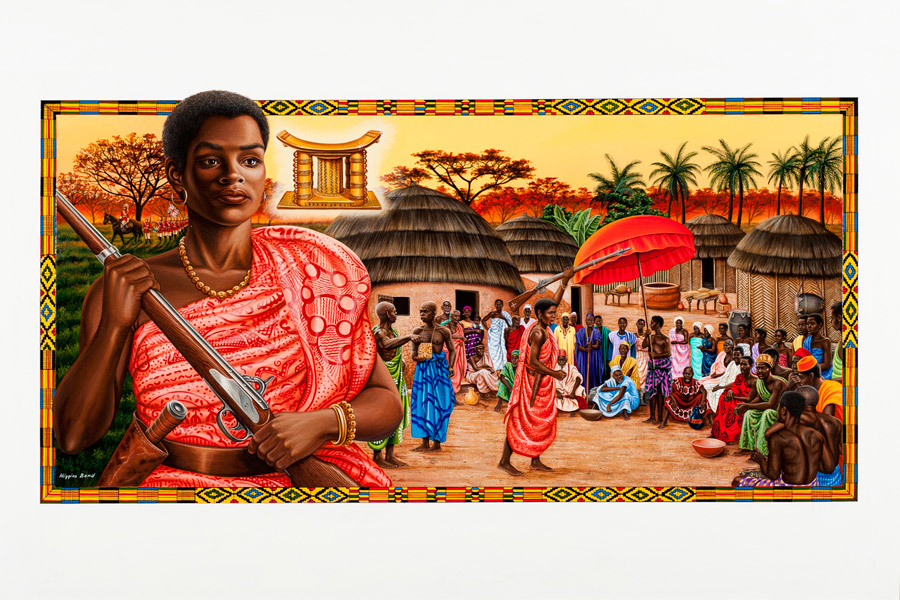“We will fight the white men. We will fight till the last of us falls in the battlefields.”
Those are the famous words from a speech Yaa Asantewaa made to the chiefs when they were weighing the options of war with the British. Yaa Asantewaa was the queen mother of the Edweso tribe of the Asante (Ashanti) in what is modern-day Ghana. She was a successful farmer and mother who became famous for leading the Ashanti rebellion against British colonialism in 1900 to defend the Golden Stool, the Asante nation’s spiritual symbol of unity and sovereignty. The Yaa Asantewaa’s War, as it is presently known in Ghana, was one of the last major wars on the continent of Africa to be led by a woman. She remains a much-loved figure in Asante history and in the history of Ghana as a whole for the courage she showed in confronting injustice during British colonialism.

Nana Yaa Asantewa, warrior and great queen mother of Ejisu who led Asantes in a war against the British
Nana Yaa Asantewaa (c. 1840–17 October 1921) (pronounced YAH a-SAN-te-WAH) was a warrior, queen mother and one of the Africa`s great freedom fighters. She was arguably Ghana and Africa`s greatest fearless female warrior during colonial times. Yaa Asantewa who was the queen mother of Ejisu (Edweso) in the Ashanti Empire—now part of modern-day Ghana—by her brother Nana Akwasi Afrane Okpese, the Ejisuhene—or ruler of Ejisu. In 1900, she led the Ashanti (Asante) rebellion known as the War of the Golden Stool against British colonialism when the British Empire after looting Ashanti Kingdom and exiling King of Asante Prempeh I, dared to ask for their Golden Stool which symbolizes their soul as Nation and an ethnic group. She is populary referred to as “Africa`s Joan of Arc.” When men panic and flee from danger, Yaa Asantewa laughs and face it squarely!

Her 1900 war with the British imperialists represented a final Anglo-Asante wars in Ghana after series of wars between them. Yaa Asantewa and her forces fought gallantly to redeem their Kingdom but they were defeated by the British who called in outside help of about 1,400 forces.
Yaa Asantewa remains a celebrated and a much-loved figure in Asante history and the history of Ghana in particular and history of Africa as a whole for her role in confronting the colonialism of the British. She is immortalized in song as follows:
Koo koo hin koo
Yaa Asantewaa ee!
Obaa basia
Ogyina apremo ano ee!
Waye be egyae
Na Wabo mmode
(“Yaa Asantewaa
The woman who fights before cannons
You have accomplished great things
You have done well”)

Students of Yaa Asantewa Gilrs` Senior High School in Kumasi demontrating Yaa Asantewa`s Warfare strategies
Prelude to the Rebellion
During her brother’s reign, Yaa Asantewaa saw the Asante Confederacy go through a series of events that threatened its future, including civil war from 1883 to 1888. When her brother died in 1894, Yaa Asantewaa used her right as Queen Mother to nominate her own grandson as Ejisuhene. When the British exiled him in the Seychelles in 1896, along with the King of Asante Prempeh I and other members of the Asante government, Yaa Asantewaa became regent of the Ejisu-Juaben District. After the deportation of Prempeh I, the British governor-general of the Gold Coast, Frederick Hodgson, demanded the Golden Stool, the symbol of the Asante nation. This request led to a secret meeting of the remaining members of the Asante government at Kumasi, to discuss how to secure the return of their king. There was a disagreement among those present on how to go about this. Yaa Asantewaa, who was present at this meeting, stood and addressed the members of the council with these now-famous words:
“ Now I see that some of you fear to go forward to fight for our king. If it [was] in the brave days of Osei Tutu, Okomfo Anokye, and Opoku Ware, chiefs would not sit down to see their king to be taken away without firing a shot. No European could have dared speak to chiefs of Asante in the way the governor spoke to you this morning. Is it true that the bravery of Asante is no more? I cannot believe it. It cannot be! I must say this: if you, the men of Asante, will not go forward, then we will. We, the women, will. I shall call upon my fellow women. We will fight! We will fight till the last of us falls in the battlefields. ”
With this, she took on leadership of the Asante Uprising of 1900, gaining the support of some of the other Asante nobility.

The rebellion and its aftermath
Beginning in March 1900, the rebellion laid siege to the fort at Kumasi where the British had sought refuge. The fort still stands today as the Kumasi Fort and Military Museum. After several months, the Gold Coast governor eventually sent a force of 1,400 to quell the rebellion. During the course of this, Queen Yaa Asantewaa and 15 of her closest advisers were captured, and they too were sent into exile to the Seychelles. The rebellion represented the final war in the Anglo-Asante series of wars that lasted throughout the 19th century. On 1 January 1902, the British were finally able to accomplish what the Asante army had denied them for almost a century, and the Asante empire was made a protectorate of the British crown.
Yaa Asantewaa died in exile in the Seychelles on October 17, 1921. Three years after her death, on 27 December 1924, Prempeh I and the other remaining members of the exiled Asante court were allowed to return to Asante. Prempeh I made sure that the remains of Yaa Asantewaa and the other exiled Asantes were returned for a proper royal burial. Yaa Asantewaa’s dream for an Asante free of British rule was realized on 6 March 1957, when the Asante protectorate gained independence as part of Ghana, the first African nation in Subsaharan Africa to achieve this feat.
Why Yaa Asantewa as a Woman led the Asantes in War?
This could be answered by looking at social roles of Asante women and role of women in Akan culture in general which is matriarchal. The confrontation of a woman, serving as political and military head of an empire, was foreign to British colonial troops in 19th century Africa. Yaa Asantewaa’s call upon the women of the Asante Empire is based upon the political obligations of the Akan women and their respective roles in legislative and judicial processes. The hierarchy of male stools among the Akan people were complimented by female counterparts. Within the village, elders known as (mpanyimfo) heads of the matrilineages, constituted with the village council known as the ôdekuro. These women known as the mpanyinfo referred to aberewa or ôbaa panyin, to look after women’s affairs. For every ôdekuro, an ôbaa panyin acted as the responsible party for the affairs of the women of the village and served as a member of the village council. The head of a division, the ôhene and the head of the autonomous political community, the ômanhene, had their female counterparts known as the ôhemma: a female ruler who sat on their councils. The ôhemma and ôhene were all of the same mogya, blood or localized matrilineage. The occupant of the female stool in the Kumasi state, the Asantehemma, and therefore, the united Asante, since her male counterpart was ex officio of the Asanthene, was a member of the Ktôtôkô Council, the Executive Committee or Cabinet of the Asanteman Nhyiamu, General Assembly of Asante rulers. Female stool occupants participated in not only the judicial and legislative processes, but also in the making and unmaking of war, and the distribution of land.

Yaa Asantewa as a Role Model for Women leadership
To highlight the importance of encouraging more female leaders in Ghanaian society, the Yaa Asantewaa Girls’ Secondary School was established at Kumasi in 1960 with funds from the Ghana Educational Trust.
In 2000, week-long centenary celebrations were held in Ghana to acknowledge Yaa Asantewaa’s accomplishments. As part of these celebrations, a museum was dedicated to her at Kwaso in the Ejisu-Juaben District on 3 August 2000. Unfortunately, a fire there on 23 July 2004, destroyed several historical items, including her sandals and battle dress (batakarikese) seen in the photograph above. The current Queen-mother of Ejisu is Yaa Asantewaa II. A second Yaa Asantewaa festival was held 1–5 August 2006, in Ejisu]
The Yaa Asantewaa Centre in Maida Vale, west London, is an African-Caribbean arts and community centre. It took its name in 1986.
A television documentary by Ivor Agyeman-Duah entitled Yaa Asantewaa – The Exile of King Prempeh and the Heroism of An African Queen was premiered in Ghana in 2001.
A stage show written by Margaret Busby, Yaa Asantewaa: Warrior Queen, featuring master drummer Kofi Ghanaba and with a pan-African cast, toured the UK and Ghana in 2001–02. A radio drama by the same author was also serialized 13–17 October 2003 on BBC Radio Four’s Woman’s Hour.
source:http://en.wikipedia.org/wiki/Yaa_Asantewaa



